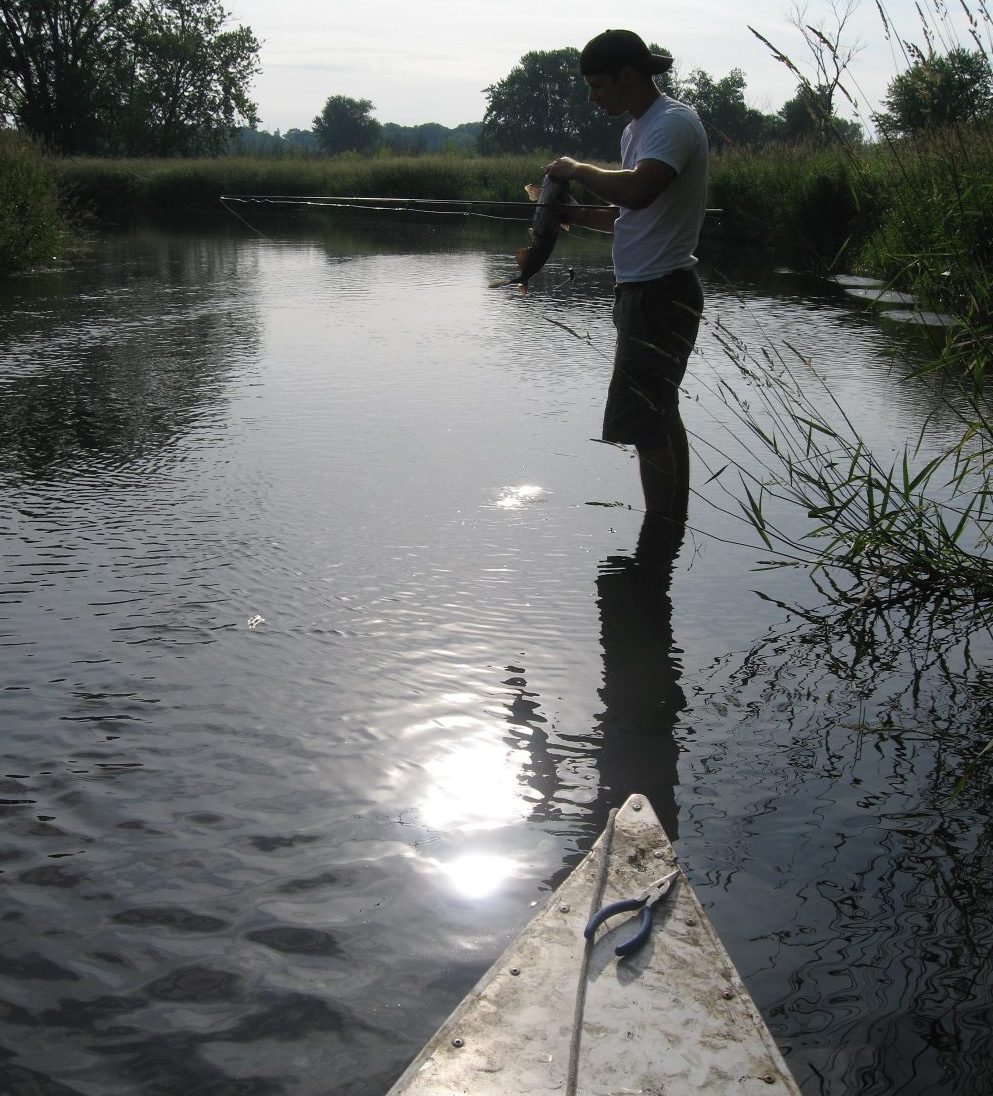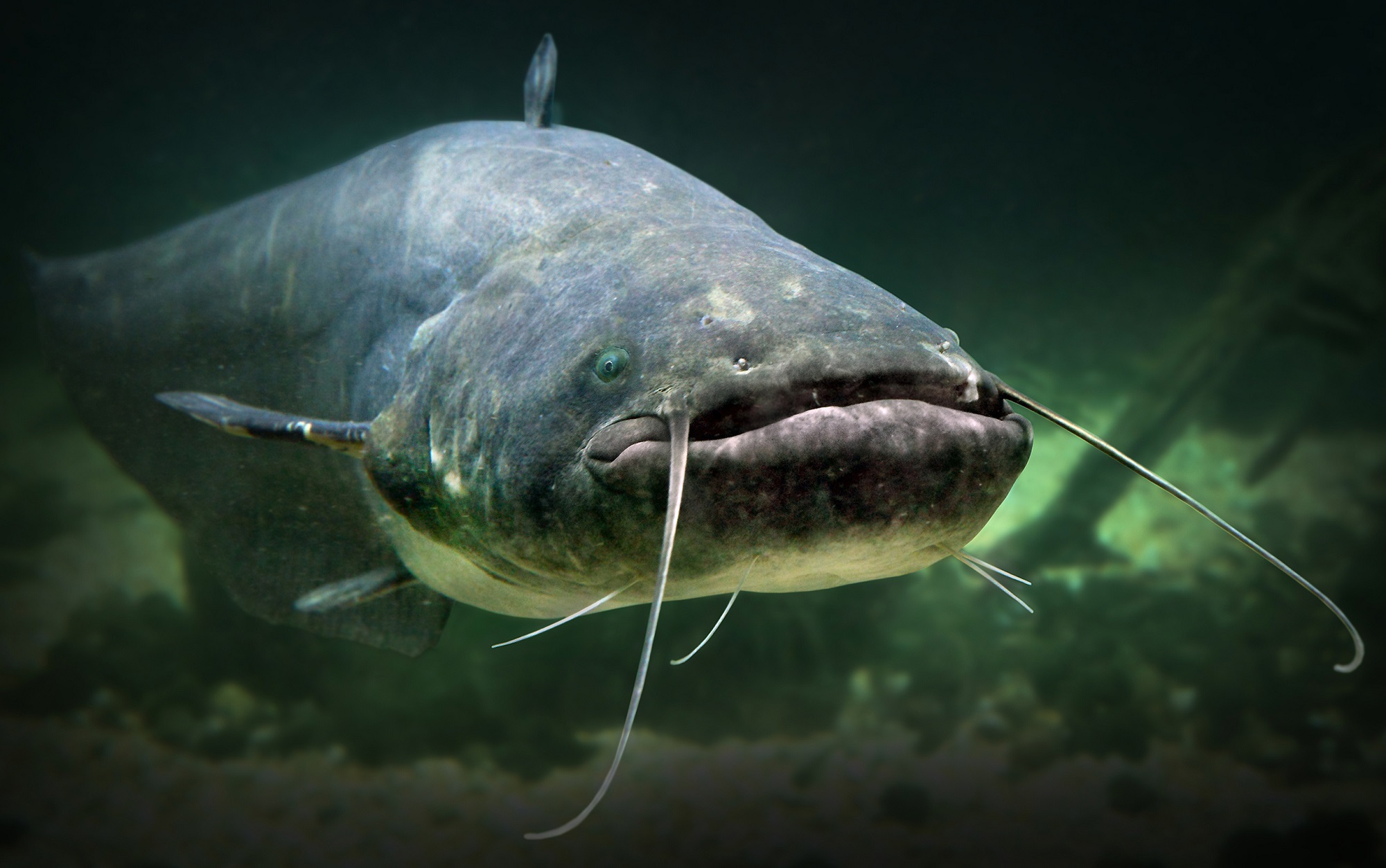Nothing gets me more fired up just after turkey season than spending a day on a small river catching big pre-spawn catfish. I’m not talking about relaxing on a padded seat in a boat with carpeted floors and wide beam length while watching your rod tips bounce, either. I’m talking about taking a canoe down a small tributary river no wider than a single lane country road and anchoring with a short rope to a paddle buried in the muck. The kind of day I’m excited about having on the river is a Huckleberry Finn kind of adventure, wading cool waters pitching to the opposite cut bank with a #4 Tru-Turn worm hook tipped with a jumbo leech and a split-shot or two while letting the river current do the work.
Best Time to Catch Catfish
Every spring is different, especially in the upper Midwest, but you can count on the bite being the best anytime between mid-May through mid-June to capitalize on big post-spawn channel cats in small tributary rivers emptying into bigger rivers. Channel catfish usually spawn when the water climbs into the mid-seventies, so I like to target the small rivers when water temperatures are in the upper-60’s to low-70’s which will be when the fish are moving into the smaller tributaries and staging for the spawn. I find these fish are more active than during the actual spawn, or shortly thereafter.
Why Small Tributaries are Great for Catfish
There are many reasons I prefer small tributary rivers over mudflats on large drainage lakes or the main river systems, some of which are a simple matter of personal preference, while others are justified. Let’s review the justified reasons and I’ll work my opinionated reasons in as I explain.
The smaller the waterbody, the easier it is to dial into key spots and target your casts. Yes – I said, “Target your casts”. Small tributary rivers are typically winding and the current carves out cut banks on the outsides of those turns. Cut banks are created by the erosion from the constant current stream being forced into the river bank on the outside turns of river bends – imagine a shelf. Catfish, along with all different fish species, will tuck into these cut banks for cover and wait for a meal to tumble by in the current. Their reactions can be intense as the catfish will dart out from under the cut bank to grab the bait, then roll in the current and swim back under the bank, nearly hooking themselves as they run.
When you fish larger bodies of water, like drainage lakes where you have a river inlet and outlet (Lake Wisconsin is a prime example), pinpointing where the fish are going to be is relatively generic – usually the mudflats during the late spring and early summer. Mudflats can be the size of a basketball court or they can be as large as several football fields. Where the catfish might be relating to on those flats is really a matter of hit or miss. That is why the traditional approach to fishing mudflats is casting multiple lines out, placing them in rod holders, and waiting. There’s nothing wrong with this approach, it’s just a matter of choosing to wait for them or going to them.
Larger main river systems typically flow in straighter lines than the small tributary rivers and streams that flow into them. While cut banks exist on larger rivers also, they are further in between and that means more time is spent looking for holes, structure (timber, bridge pilings, rip-rap, wing dams), and cut banks to target.
Because of the winding nature of smaller tributary rivers and streams, cut banks and holes exist around every corner, making it quick and easy to run-and-gun from one spot to the next, hole hopping all the way down to where the little river meets the bigger river.

The author holds a catfish caught on a small river.
Another reason I prefer small tributaries is better water clarity – they’re typically spring fed, or flowing out of spring-fed headwaters, like a marsh with a lake. Marsh lakes are filled with heavy vegetation which serves as a filtration system, thus the water that flows from them starts out clear and remains relatively clean throughout its journey downstream. Drift fishing with a plain hook and a split shot flowing downstream with the current certainly doesn’t require high-visibility to be a successful tactic for catfish, but it sure does help. In fact, did you know catfish can taste with their tails?
Before you call me crazy, understand that catfish are one of the most unique freshwater fish on the planet. Did you know that catfish have more than a million taste buds all over their body? I first heard of catfish tasting with their whiskers and tails by the words of Otis “Toad” Smith, in some of the earlier In-Fisherman catfish VHS videos with Doug Stange. Since then the internet has enlightened many of the ponderings I’ve stored in the back of my mind and questioned the authenticity of. Now that I’ve learned the science backing up Toad’s claims, I better understand how catfish can find a motionless meal in mud-stained water.
Catfish prefer warmer water in the spring and early summer because it’s more suitable for the spawn. Since smaller tributaries warm faster than the larger main river systems, I prefer to target the areas I have the most confidence the catfish will migrate to. Warmer water in the spring is a magnet for these fish, so why not fish where the majority will be staging rather than searching for dispersed fish in the main river?
Navigating Small Rivers
The rivers I generally target are narrow, like the width of a single lane country road minus the shoulders. Depth is variable on these little rivers and the current can be difficult to row against, so I much prefer a canoe or a kayak over anything else. It’s not uncommon for most river bends on these small tributaries to have sandbanks on the inside of the turn, and deep holes with a cut bank on the outside of the river bend. I’ll usually wear shorts, or roll up light-weight pants, climb out of the boat and stab my paddle deep into the sand to anchor the canoe by a short four-foot rope.
I’ll then wade the river along the exposed emergent sandy river bank and pitch short casts upstream and tight to the opposite bank. Doing so allows the bait to sink to the bottom and flow with the current just along the edge of the eroded bank on the opposite shore, meanwhile, I keep a relatively tight line and point the tip of my rod in slow swinging motion keeping up with the bait in the current. Once I feel the bait has reached the end of the hole I’ll reel in slowly in case it provokes a walleye or a heavy bass to slam it before it makes it in for another cast. One of my favorite things about fishing rivers is you never know what you’re going to catch with live bait, even when you’re targeting a specific species.
One important tip I can’t stress enough is to use a pad on the bottom of your canoe to dampen the metallic percussion from dropping items on the floor of the boat, and even the thud of your feet and other gear when shuffling around. The sensory organs of a catfish are as keen as a whitetails nose. Why let them know you’re there if you’re trying to take them by surprise? Consider looking into a cheap strip of carpet cutout to place on the floor – it’s lightweight and will do the job.
Tackle for Catfish
Many prefer to use circle hooks for fishing catfish, but I’ve always sided with a lighter wire hook because I’m relying on the current to create the movement of my presentation while I’m simply keeping up with the slack in my line and feeling for bites. Circle hooks are great for keeping fish hooked because of their shape, and they’re also very durable – another compliment of their design, but I have never been a fan of the hook-ups versus that of an offset shank on a hook. Which is why I prefer Tru-Turn worm hooks, as their offset design naturally turns the point of the hook in the immediate direction of whatever is grabbing at the bait for the best hookup odds. Tru-Turn hooks are also durable, despite their thin lightweight construction. If you don’t use a Tru-Turn worm hook, I highly recommend you spend that extra bit of time bending the hook to offset the alignment of the point of the hook and actual vertical shank.
As for hook size, I’ve used #4 and #6 for durability and gap between the point and the vertical shank. The wider the gap, the better your hookups will be. Also, the smaller the hook, the weaker its construction and ability to hold strong against a tussling 10-pound catfish. After learning many lessons the hard way, the #6 is the smallest I will go, and #4 is the largest I will go. I have found that hooks larger than #4 can be overly aggressive and I’ve gotten fewer bites on them. Perhaps the fish feel the larger hook before committing a full bite down and then spit the bait, but whatever the reason, it’s not worth missing fish over. In the end, just get out there and explore some of those smaller rivers you’ve often overlooked – there just may be some giant catfish waiting for your bait.






